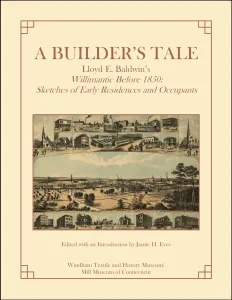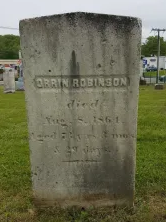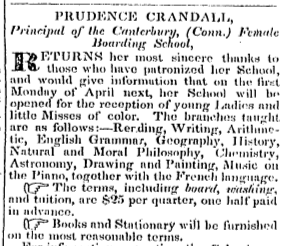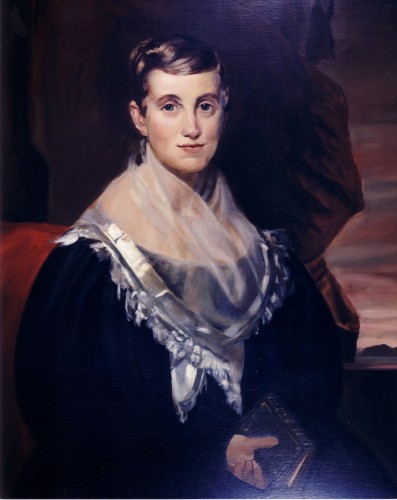Melissa Zablonski
Putnam High School
TEACHER'S SNAPSHOT
Subjects:
African Americans, Slavery & Abolition, Social Justice
Course Topics/Big Ideas:
Role of Connecticut in U.S. History, The Struggle for Freedom, Equality, and Social Justice
Town:
Canterbury, Windham
Grade:
Grade 8, High School
Lesson Plan Notes
“An ally will mostly engage in activism by standing with an individual or group in a marginalized community. An accomplice will focus more on dismantling the structures that oppress that individual or group.” – Colleen Clemens, 2017
Throughout the 1800s and until the end of the Civil War, abolitionists fought to end slavery throughout the United States. Following the Civil War, activists fought to secure equal rights for African Americans in the country. In this lesson, students will use the examples of Orrin and Jerusha Robinson and Prudence Crandall to explore the differences between being an anti-racist ally and anti-racist accomplice and reframe their thinking about white abolitionists.
ESSENTIAL QUESTION
SUPPORTING QUESTIONS
- What makes a person or group an anti-racist ally or anti-racist accomplice?
- How did the congregants of the Willimantic Methodist Church act as allies or accomplices in the fight against slavery in Connecticut?
- How did Prudence Crandall act as an ally or an accomplice in the fight for African American rights in Connecticut?
ACTIVITY
Introduction
- Teacher writes the term “Ally” on a piece of chart paper and “Accomplice” on a second piece of chart paper.
- Students take turns writing words or phrases that come to mind when they read those terms.
- As a class, discuss the differences between allies and accomplices and how these terms might apply to anti-racist efforts.
Activity #1
- Students read each of the four sources. Two relate to the “Methodist Melee” in Willimantic, and two relate to Prudence Crandall’s school in Canterbury.
- While reading, students complete the graphic organizer for each source, listing evidence that shows the Robinsons and Crandall as anti-racist allies or accomplices.
- After reading and completing the graphic organizer, students will make a claim about whether the Robinsons and Crandall should be remembered as anti-racist allies or accomplices. They will share their claims in groups of 2-4, providing evidence to support their ideas.
Activity #2:
- The teacher will post the Ally chart paper on one side of the room and the Accomplice chart paper on the other side of the room to create a spectrum.
- After discussing in their groups, students will be asked to situate themselves on the spectrum to show where they feel the Robinsons fall on the Ally to Accomplice scale. They will do the same for Crandall.
- Students will lead the discussion, justifying why they placed themselves at their spot on the spectrum. The class will try to come to a consensus about how the Robinsons and Crandall should be remembered: as allies or accomplices.
OPPORTUNITIES FOR ASSESSMENT
Option #1: Students will choose to write from the perspective of either the Robinsons or Prudence Crandall. From that perspective, students will write a letter from their chosen historical figure that provides advice and examples on how to be an anti-racist ally or accomplice to someone in the present day. While writing the letter, students should consider:
- How did their historical figure demonstrate themselves to be an ally or accomplice?
- What should others learn from their actions?
- What steps should someone take today in order to be an ally or accomplice?
- Why is this work important? What is the potential impact?
Option #2: Students will create an action plan for becoming an ally or accomplice in their own communities. What can students do as individuals or groups to be an anti-racist ally or accomplice? What steps will they need to take to achieve this? How will their actions help the community?
RESOURCE TOOL KIT

Excerpt from: Jamie H. Eves, ed., A Builder’s Tale: Lloyd E. Baldwin’s Willimantic Before 1850: Sketches of Early Residences and Occupants (Willimantic, CT: Windham Textile and History Museum, 2009)

Excerpt from: “Orrin and Jerusha Robinson and the Methodist Melee on Main Street.” Jamie H. Eves.

Advertisement and Notice Regarding the Opening of a “High School for Young Colored Ladies and Misses.” The Liberator (March 2, 1833). Courtesy Gilder Lehrman Center for the Study of Slavery, Resistance, and Abolition at Yale University.

Prudence Crandall, “Letter to Simeon Jocelyn (April 17, 1833)” published in “Abolition Letters Collected by Captain Arthur B. Spingarn” Journal of Negro History, vol. XVIII, 1933, p. 82-84. Courtesy Gilder Lehrman Center for the Study of Slavery, Resistance, and Abolition at Yale University.
ADDITIONAL RESOURCES
Places to GO
Windham Textile and History Museum – The Mill Museum, Willimantic
Prudence Crandall Museum, Canterbury
Things To DO
Visit the exhibit: Here All Along: African Americans in Northeastern Connecticut Before the Great Migration at the Windham Textile and History Museum.
Websites to VISIT
A Canterbury Tale: A Document Package for Connecticut’s Prudence Crandall Affair, Gilder Lehrman Center for the Study of Slavery, Resistance, and Abolition
National Women’s History Museum – Prudence Crandall
Connecticut Women’s Hall of Fame Inductees Gallery: Prudence Crandall
Articles to READ
“Ally Or Accomplice? The Language of Activism” by Colleen Clemens. June 5, 2017, Learning for Justice.
“Prudence Crandall Fights for Equal Access to Education” by Diana Moraco. ConnecticutHistory.org.



